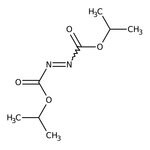Search Thermo Fisher Scientific
Diisopropyl azodicarboxylate, 94%, Thermo Scientific Chemicals



Diisopropyl azodicarboxylate, 94%, Thermo Scientific Chemicals
Chemical Identifiers
Specifications
Description
This Thermo Scientific Chemicals brand product was originally part of the Alfa Aesar product portfolio. Some documentation and label information may refer to the legacy brand. The original Alfa Aesar product / item code or SKU reference has not changed as a part of the brand transition to Thermo Scientific Chemicals.
Diisopropyl azodicarboxylate is used as an important reagent in the production of many organic compounds. It is used in association with triphenyl phosphine in Mitsunobu reaction of alcohols, acids and amides. It acts as reactant in the preparation of chromenes resembling classical cannabinoids, norbornene-based guanidine-rich polymers and acceptor-donor-acceptor organic dyes.
Solubility
Immiscible with water.
Notes
Store in cool place. Light sensitive. Incompatible with strong oxidizing agents, strong bases, alcohols and metallic salts. Decomposes violently at or above: 100 0C.
Figures
Documents & Downloads
Certificates
Frequently asked questions (FAQs)
Citations & References
Safety and Handling
Classification of the substance or mixture
CLP classification - Regulation(EC) No 1272/2008
Label Elements
Signal Word
Warning
Hazard Statements
H315 - Causes skin irritation
H319 - Causes serious eye irritation
H335 - May cause respiratory irritation
H373 - May cause damage to organs through prolonged or repeated exposure
H411 - Toxic to aquatic life with long lasting effects
Precautionary Statements
P280 - Wear protective gloves/protective clothing/eye protection/face protection
P302 + P352 - IF ON SKIN: Wash with plenty of soap and water
P304 + P340 - IF INHALED: Remove person to fresh air and keep comfortable for breathing
P312 - Call a POISON CENTER or doctor if you feel unwell
P332 + P313 - If skin irritation occurs: Get medical advice/attention
P337 + P313 - If eye irritation persists: Get medical advice/attention